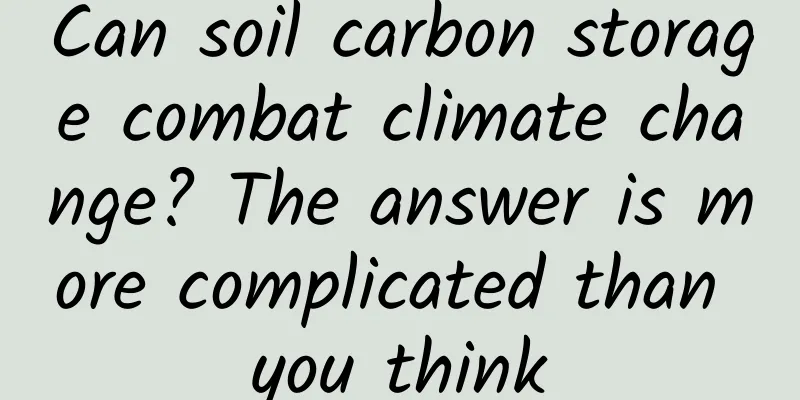Can soil carbon storage combat climate change? The answer is more complicated than you think

|
Plants convert carbon dioxide into roots, stems, and leaves through photosynthesis. The fallen branches and leaves and root products are buried in the soil and converted into soil organic matter. This is the traditional soil carbon sink. In simple terms, soil can absorb, convert, and store carbon dioxide from the atmosphere through plants. However, recent studies have shown that the truth may not be that simple. This has to start with the complex composition of soil. A teaspoon of healthy soil contains more bacteria, fungi and other microorganisms than humans on Earth. Soil humus has always been considered to be a type of complex and stable macromolecular organic matter formed during the humification process of organic materials, with the emphasis on the word "stable". However, recent studies[1] have shown that “current evidence does not support the formation of large, persistent ‘humus’ in soils.” Over the past decade or so, most soil scientists have come to accept this view. Yes, soils vary widely and contain a lot of carbon. But this carbon is not stored away forever, unbroken. "The properties and characteristics of soil, the stuff that's in the textbooks, the theory of soil organic carbon accumulation has been proven to be mostly wrong ... but we still stick to it," said Greg Sanford, a soil researcher at the University of Wisconsin-Madison. This will not only lead to more considerations for soil-based nature-based solutions, but will also cause serious deviations in previous climate models. Studies have shown that soil carbon storage capacity is highly sensitive to temperature changes, which has a significant impact on important carbon pools such as tropical rainforests [2]. In addition, the carbon sequestration and emission reduction potential of agriculture also needs to be considered. Soil organic carbon pool accounts for about 2/3 of the entire terrestrial ecosystem, about 3 times the plant carbon pool and 2 times the atmospheric carbon pool. According to the data in the Second National Assessment Report on Climate Change, the reserves of China's soil carbon pool are about 102.96 billion tons. If the carbon credit calculation based on this data is wrong, the time we have to mitigate climate change may be much shorter than we think. In terms of agriculture, the 2015 United Nations Paris Climate Change Conference proposed the "4/1000" initiative, which aims to increase the organic carbon storage of global agricultural soils by an average of 4/1000 per year. The European Union and other countries have also issued sustainable agriculture bills, hoping to accelerate the natural carbon sequestration process from the soil. In addition to soil degradation, compaction, acidification, salinization, nutrient imbalance, erosion and other problems, we also need to consider in detail the impact of agriculture on soil carbon storage capacity. In recent years, soil science researchers have been studying how to really and continuously fix carbon in the soil. Salk's team proposed the idea of using plants rich in suberin to fix carbon in the soil. In April 2021, the United States proposed paying farmers to grow cover crops to nourish the soil. (There is evidence that when the roots of cover crops decompose, some of their carbon remains in the soil.) However, whether these practices are really effective will take time to consider. (Content reference: https://advances.sciencemag.org/content/7/21/eabd1343) Text/Stan Review/YJ [1] Lehmann, J., Kleber, M. The contentious nature of soil organic matter. Nature 528, 60–68 (2015). https://doi.org/10.1038/nature16069 [2] Nottingham, AT, Meir, P., Velasquez, E. et al. Soil carbon loss by experimental warming in a tropical forest. Nature 584, 234–237 (2020). https://doi.org/10.1038/s41586-020-2566-4 |
Recommend
Chat-GPT is so powerful, but it can’t say exactly 10 words?
Recently, you may have heard about various chatbo...
Rather than worrying about whether you can eat shrimp heads, you should pay more attention to this issue.
Audit expert: Wang Guoyi Postdoctoral fellow in N...
Pinduoduo Operations: What tricks does Pinduoduo use to get things for free through bargaining?
The bargaining and free-getting activities that h...
Is it easier to gain weight in summer? 8 ways to stay away from fat
A woman called me and asked me: Other people gain...
Is there anything we can learn from Japanese companies now that they have fallen from their pedestal?
Once upon a time, the distinctive characteristics...
How much does it cost to recycle an old computer? How much does it usually cost to recycle an old computer?
Don't expect to sell it for much. Second-hand...
There are still 4.4 billion people on Earth who don’t have access to the Internet
A report shows that there are still 4.4 billion p...
The top 20 best-selling items dropped 71% year-on-year. Are card games on the decline?
[[139416]] Introduction Looking back at the new m...
Chinese scientists have discovered a new drug for the treatment of COVID-19! Can cephalothin really cure COVID-19?
Recently, a new drug for the treatment of COVID-1...
How to create a hit title with over 100,000 views? Just master these 5 points!
Let’s take you to re-examine the meaning of title...
How to control the degree of good news push?
As the most important means of operating mobile A...
Three new marketing strategies: e-commerce of influencers, social marketing, and brand entertainment!
I look older but my voice is younger, so please d...
Growth case analysis: How to attract new users?
Internet practitioners must be familiar with invi...
After the disappointment of 2016, will smart hardware make a comeback?
Compared to 2015, there are not many smart hardwa...
I never thought that these things that we use every day are dirtier than toilets! How can we clean them more effectively?
Wake up to the alarm in the morning Fingers flyin...









